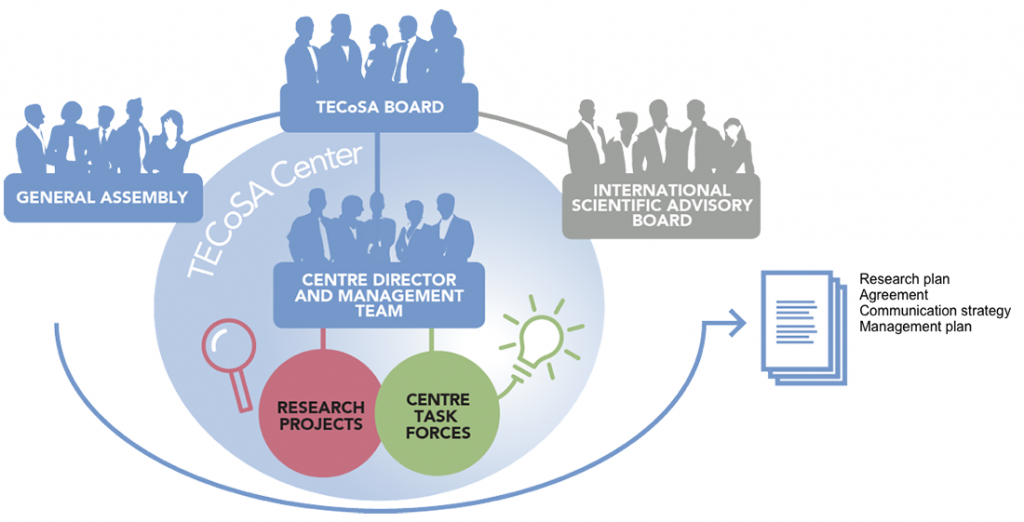The TECoSA organization is developed to create conditions that facilitate a successful implementation of the vision and strategy, with a management team and several task forces.

The center director and management team lead the operation of the center. The management team is composed of the center director and co-director, the task force leaders, and an administrative manager. The management team gathers data to follow up the performance of the center, and prepares relevant reports.
The TECoSA board comprises in total of seven members with the chair position taken from industry. Industry is represented by in total five members, and KTH by the remaining two positions. The board meets 3–4 times per year.
ISAB
The international scientific advisory board (ISAB) is appointed by the board and consists of at least three leading international scientists from academia and industry covering relevant fields of TECoSA. The ISAB will be invited to annual TECoSA events.
Task forces
The task forces of the center have the role to coordinate and ensure continuity of concrete activities, essential for the long-term operation of the center. Each task force has a leader, responsibilities and a budget. Coordination is provided through the management team.
Center development
This task force has the goal of driving center renewal, including work on the collaborative SRA, defining and refining KPIs to capture key success factors and expected results, and interactions with relevant external stakeholders to elicit complementary perspectives. The task force also has the role for organizational development including promoting an innovative and equal opportunities culture. The task force will further work towards long-term center sustainability by monitoring and assessing funding opportunities, as well as investigating organizational setups for a continuation beyond 10 years.
Networking and visibility
This task force is responsible center promotion and stakeholder engagement through the interactive website, hosting international conferences, organizing the annual TECoSA conference (where center results will be presented and demonstrated), a bi-directional visitors exchange program, a distinguished lecture series and executive events. A further role is to arrange interactions with relevant external stakeholders such as funding agencies, international networks and VINNOVA innovation programs.
These interactions include invitations to the TECoSA conference and meetings. Finally, the outreach activities will support the creation of inspirational events, such as the grand cooperative driving challenge56.
Education and mobility
KTH hosts a large portion of the Swedish engineering education and thus has an essential responsibility to provide engineers that are prepared for the future. Current education and research, suffer from fragmentation – both in terms of providing perspectives beyond disciplines (e.g. computer science, control, communications) and also in actually adopting best practices in education (such as those documented by the CDIO initiative). TECoSA, with its multidisciplinary team and industrial partners is here very well positioned in order to improve education and emphasize life-long learning.
This includes course and program renewal, a doctoral school and a postdoc program. The task force will include representatives from both academia and industry. An initial assignment for this task force is to organize a multidisciplinary tutorial oriented course to bridge disciplinary gaps. Finally, the task force will promote interest among students, building coherence across disciplines and activities to promote gender balance in the area.
TECoSA OEEE and demonstrators
This task force has the role to plan and coordinate the OEEE, including the use of open source software and the industrial resources used in this environment, as well as the access to and use of more closed industrial environments. TECoSA has as a goal that most project results will be demonstrated through the OEEE. Some results will also be made part of and demonstrated in industrial environments. We note that this type of coordination is rather new for KTH – it has not been carried out at this scale in this area before and thus provides an opportunity for more efficient and longerterm collaboration.
The strategy, strategic research agenda, agreement (including the IMP) and work practices are documents worked out by all partners, setting the scope of the work and interactions in TECoSA. The work practices describe the intended operation of the task forces, involved roles, expectations and code of conduct.